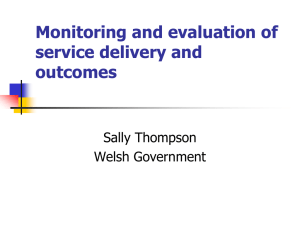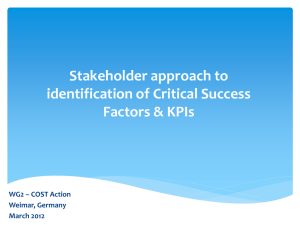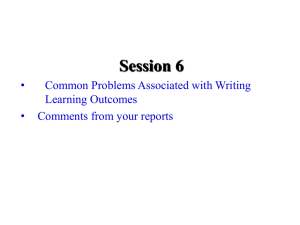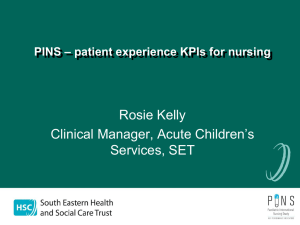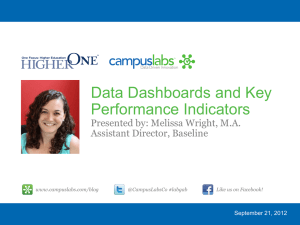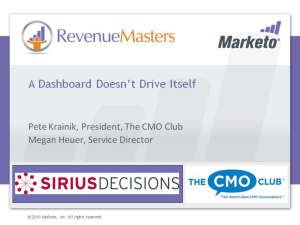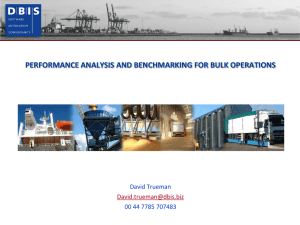Use of KPIs in an Integrated Decision Support System for Energy
advertisement
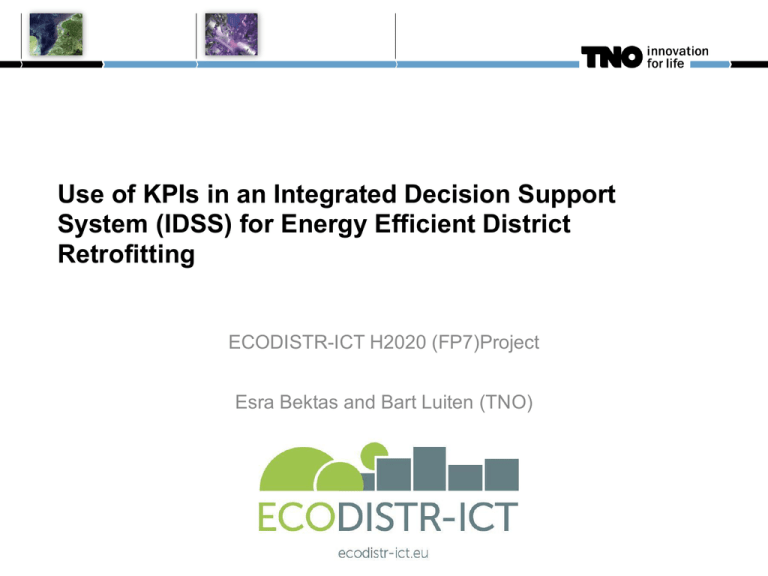
Use of KPIs in an Integrated Decision Support System (IDSS) for Energy Efficient District Retrofitting ECODISTR-ICT H2020 (FP7)Project Esra Bektas and Bart Luiten (TNO) Structure Section 1: Background –the necessity for the IDSS and use of KPIs Section 2: Modelling the Decision Process that the IDSS supports Section 3: Inclusion of KPIs in the IDSS supported decision process 1. BACKGROUND Background: Complex Decision Process in Energy Efficient Urban Retrofitting Multi-stakeholder, with a wide range of stakes and priorities Is boosted due to incorporation of both selecting and using different sustainability measures dealing with each stakeholder’s vision, financial capacity, and different performance expectations. Multiple decision levels Multiple time horizons Multiple KPIs ++++++ Not only rational decisions but intuitive Dynamic process ECODISTR-ICT project ECODISTR-ICT aims to enable local authorities, architects and urban planners planning in making decisions on retrofitting of districts through a new open source software tool. Called the Integrated Decision Support System (IDSS) • The IDDS refers to a ‘software backbone’ that integrates existing design and calculation modules rather than developing a new ones. • The IDSS facilitates decision making through credible input for selection and incorporation of measures in design phase. The IDDS Components a) Graphical User Interface (GUI), b) the Dashboard, and c) The Framework. Critical Observations When such complex, dynamic, iterative –sometimes intuitive process is mediated by computers. There is a probability to end up with a rigid and prescriptive decision model, which does not correspond to the stakeholders’ practices. If/when included, to focus on KPIs scores rather than how can be instrumented for the stakeholders in making choices. --or– a clear decision model but the way missing the way that KPIs are used. The Need regarding the KPIs in the IDDS There is a need to define decision model that the IDSS can support yet to be dynamic, iterative, fit-to-the purpose. There is a need to identify the use of KPIs that stakeholders require and the way to support it through the IDSS. There is a need to define the support via the integrated environment, which synthesizes the calculation modules and assessment modules for selected KPIs. 2. The Decision Model for the IDDS Decision Process: Why to model and plan? Having higher chance to establish clear goals and ambition, made a conscious and directed series of choices. Providing a standard of measurement, to direct whether decision maker go towards or further away from the ambition. Enabling to convert values to action iteratively to advance the plan best Clarifying the boundaries To manage the commitments Carpenter et al. (2009) Steinitz (2013) Kepner et al. (1965) Decision Theories Decision steps defined by Carpenter et al. Design steps in geo design context of Steinitz (2013) (2009) The Decision Process for the IDSS ECODISTR-ICT Decision Process Phase A: Defining Ambition Example: High level ambition : Flourished cities… District to be flourished!! Analyse problem Collect data • Energy consumption is too high. Data collection modules • Buildings are deteriorated. • Housing typology is not suitable anymore to the families. • Maintenance is (poor and) expensive. • Vacant buildings are too many. • There is insufficient greenery. • There is insufficient facilities for inhabitants. • Crime rate is too high. <District to be flourished> Identify stakeholders Problem statement Selected KPIs Analyse problem Identify & Select KPIs Collect data • Energy consumption is too high. [City] • Buildings are deteriorated. [Investors] Data collection modules • Housing typology is not suitable anymore to the families. [Investors/Citizens] • Maintenance is (poor and) expensive. [Housing Associations] • Vacant buildings are too many. [City] • There is insufficient greenery. [Citizens] • There is insufficient facilities for inhabitants. [Citizens, Housing Associations] • Crime rate is too high.[Citizens] AS-IS data to enable assessment Assess ASIS Energy-efficiency neutrality Quality of buildings Comfort Flexibility Easy-Maintenance Maintenance cost Attractiveness Greenery Sufficiency of facilities Safety Assess AS-IS Districts scored XX in aspect Assessment modules KPI’s + AS-IS score Define TO-BE ambition Gap between TOBE and AS-IS KPI’s + values District flourishing; [Input to Program] - Create small-businesses and cultivating economic activities - Create attractiveness to the vacant office stock there - Improve housing stock’s quality (%) - … - … - … ECODISTR-ICT Decision Process Phase B: Selecting Best Alternative 3. Inclusion of KPIs in the IDSS supported decision process user manually do elsewhere user via the IDSS ICT-ICT automatically(dahboard-framework &framework-module connections The legend to read the IDSS supported actions in the decision process KPI Inclusion in Defining Ambition Phase Basic Step A1 Analyse problem Define the problem & the users A2 Collect data A3 Assess AS-IS Visualization and KPI’s ASIS Calculation module Select & Manage KPIs Data colection prior to assesment 2. Define and select KPIs by a)-selecting certified full KPI sets, b) choosing KPIs from sets, c) adding new KPIs 1. Create contexts Run calculation module for assesing AS-IS scores 2. Inform which data (in which level of detail) is needed for calculation Dashboard connects automatically to the calculation modules registered to the IDSS 3. Enable uploading the data for calculation -or-Run calculation module outside of the IDSS and add values for acquiring scores of KPIs, when the calculation modules are not coupled to the IDSS. A4 Define TO-BE Ambition Define the gap between AS-IS and TO-BE Ambition Actions 1. Capture the users /the stakeholders present; define geographical area; define the context of the problem 3. Management of the content of KPIs Definition of scores, prioritization of KPIs, selection of calculation modules. ++ Check the consistency/ sufficiency of the data uploaded Show alert about the missing data through modules 1.Visualize AS-IS scores as reference point prior to KPI target values 2. Define TO-BE ambition KPI Inclusion in Defining Ambition Phase Basic Step Actions B1 Develop alternatives B2 Asses alternatives B3 Select best alternative Designing modules in fixed context Calculation modules with different context Best alternative and the chosen context 1. Inform the user about the list of measures in relation with the selected KPIs 1. Run calculation Modules for each selected variant Providing a ‘scoreboard’ as a summary that the final decision can be made. 2. Administer alternatives; choose /modify contexts (if necessary), and make variants 3. Upload data/design models 2. Visualize the scores of AS-IS, TO-BE Ambition and the scores, the context and the alternative used in each variant. --When possible-4. Access to design Modules Sense making between KPI scores and target values and decide Conclusions & Discussions on Does the modelled and ‘rationalized’ decision process seem recognizable? How can we ensure the balance should be in proposing rationalized decision process and ‘irrationality’ of the decision makers which is natural and can play great role in making choices? How can we improve our decision model and make applicable for other contexts? THANK YOU. Example: High level ambition : Flourished cities… District to be flourished!! Analyse problem Collect data • Energy consumption is too high. • Buildings are deteriorated. • Housing typology is not suitable anymore to the families. • Maintenance is (poor and) expensive. • Vacant buildings are too many. • There is insufficient greenery. • There is insufficient facilities for inhabitants. • Crime rate is too high. <District to be flourished> Problem statement Selected KPIs Analyse problem Collect data • Energy consumption is too high. [City] • Buildings are deteriorated. [Investors] • Housing typology is not suitable anymore to the families. [Investors/Citizens] • Maintenance is (poor and) expensive. [Housing Associations] • Vacant buildings are too many. [City] • There is insufficient greenery. [Citizens] • There is insufficient facilities for inhabitants. [Citizens, Housing Associations] • Crime rate is too high.[Citizens] Identify stakeholders Identify & Select KPIs Assess ASIS Energy-efficiency neutrality Quality of buildings Comfort Flexibility Easy-Maintenance Maintenance cost Attractiveness Greenery Sufficiency of facilities Safety Inclusion of KPIs in Analyzing the Problem 1. Capture the users of the IDSS, the stakeholders present; define geographical area; define the context of the problem, User makes a sub-set of KPIs depending on the problem & high-level ambition. 2. Define and select KPIs by a)-selecting certified full KPI sets, b) choosing KPIs from sets, c) adding new KPIs. 3. Management of the content of KPIs, definition of scores, prioritization of KPIs, selection of calculation Modules. a) Choose a certified full KPI set (i.e., from BREEAM, Open House, and Super Buildings); b) Select KPIs from existing sets; c) Adding new KPIs (when existing KPIs do not satisfy the specific needs of the stakeholders for the specific case). Inclusion of KPIs in Collecting Data 1. Inform the user about which data (in which level of detail) is needed for the assessing AS-IS, User explores what data is needed for the selected KPIs 2. Create contexts 3. Enable the user to upload the data that will be used for the calculation and check the consistency/sufficiency of the data uploaded. Inclusion of KPIs in Assessing AS-IS situation 1. Run calculation Module via Dashboard for assessing AS-IS, 2. Run calculate elsewhere (i.e. separate Module) and manually add User runs calculation Modules and gathers scores for each KPI Figure 1 values to KPIs which are created/defined in the IDSS but not either automatically or directly calculated via the IDSS. The inclusion of KPIs in Assessing AS-IS (step A3) Inclusion of KPIs in Defining TO-BE Ambition 1. Visualize AS-IS scores as reference point prior to KPI target values 2.(Re) Prioritize and define target values of KPI's based on AS-IS scores and boundary conditions of the stakeholders. User re-evaluates priorities, and, if necessary, re-do Phase A of the decision process. Figure 1 --When necessary-Re-select KPIs/ KPI Modules, run calculation and get new results, then (re)define TO-BE ambition . Prioritizing and define target values for KPIs (step A4) Inclusion of KPIs in Developing Alternatives 1. Inform the user about the list of measures in relation with the selected KPIs User develops alternative 2. Administer alternatives; choose /modify contexts (if necessary), solutions to meet the TO-BE and make variants ambition 3. Upload data/design models --When possible-4. Access to design Modules Figure 1 Developing alternatives (step B1) Inclusion of KPIs in Assessing Alternatives 1. Run calculation Modules for each selected variant User asses design alternatives and make 2. Visualize the scores of AS-IS, TO-BE Ambition and the scores, the context and the alternative used in each variant. adjustment. Figure 1 The alternatives are assessed against the AS-IS and TO-BE situation (step B2) Inclusion of KPIs in Selecting the Best Alternative 1. Providing a ‘scoreboard’ as a summary that the final User evaluates the alternatives decision can be made. by the score of the KPIs. Figure 1 The best alternative is selected (step B3) Decision Levels
